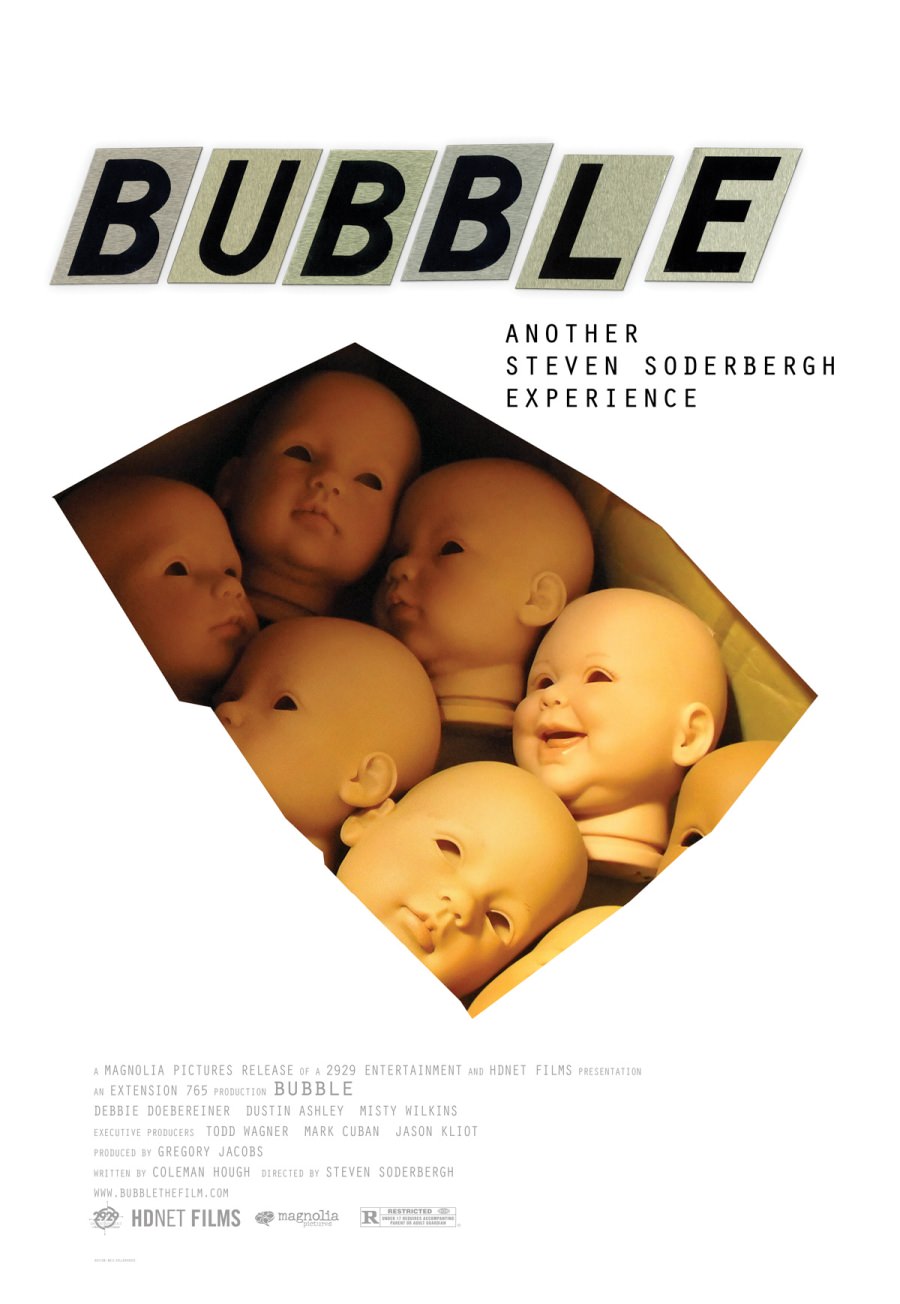Bubble

 Middle-aged Martha (Debbie Doebereiner) and young Kyle (Dustin James Ashley) work in a doll factory in southern Ohio, near the Ohio River. Their work, shown in quiet (except for the low thrum of machinery) montages is repetitious, exacting and a little macabre; Kyle pulls rubbery hot doll heads out of machine holes, while Martha spray paints heads and glues hair on bald baby scalps. Their lives are predictable and monotonous, although scraping for money is a constant; Kyle and many of his co-workers work two jobs. He’s saving to buy a car. Martha’s single and shows perhaps an inordinate amount of concern for Kyle’s well-being. Kyle is quiet and shy and has social anxiety.
Middle-aged Martha (Debbie Doebereiner) and young Kyle (Dustin James Ashley) work in a doll factory in southern Ohio, near the Ohio River. Their work, shown in quiet (except for the low thrum of machinery) montages is repetitious, exacting and a little macabre; Kyle pulls rubbery hot doll heads out of machine holes, while Martha spray paints heads and glues hair on bald baby scalps. Their lives are predictable and monotonous, although scraping for money is a constant; Kyle and many of his co-workers work two jobs. He’s saving to buy a car. Martha’s single and shows perhaps an inordinate amount of concern for Kyle’s well-being. Kyle is quiet and shy and has social anxiety.
The co-workers’ routine is interrupted one day with the arrival of a new hire, young and pretty Rose (Misty Dawn Wilkins). In a masterfully shot scene, Kyle and Rose are attracted to each other at first sight, as Martha watches their body language while their boss drones on. Rose, sharing lunch with the other two every day, begins to spend smoke break time with Kyle away from Martha and seeds of conflict and jealousy are sown. Martha (rightly) warns Kyle of dubious things she’s seen Rose do.
The way the relationships slowly develop and alter is one of the film’s great strengths. The lobby poster for Bubble promised “Another Steven Soderbergh Experience.” This was truth in advertising; watching Bubble is quite the experience. Going in to the film cold, I wasn’t prepared for how involving the story would be. It uses radical, experimental means to portray a small, intimate story.
Soderbergh uses several techniques to advantage. He shot the film quickly, in HD video. He worked his own editing of the film and cinematography. He used music sparsely, hiring Robert Pollard of Dayton’s Guided By Voices to contribute solo guitar work and also thereby keeping the movie grounded in Ohio. Lastly and most importantly, the people he cast weren’t/aren’t actors, but everyday workers found in Belpre, Ohio and nearby Parkersburg, West Virginia (the film was shot in Belpre). The writer, Coleman Hough, gave the cast cues to progress the plot, but allowed them to  improvise the dialogue, drawing on their own working class experiences. This, and the cast’s serious commitment to the material, gives the film a cinema vérité -like realism that’s extraordinarily compelling.
improvise the dialogue, drawing on their own working class experiences. This, and the cast’s serious commitment to the material, gives the film a cinema vérité -like realism that’s extraordinarily compelling.
Hough found Debbie Doebereiner working as a KFC manager. Misty Dawn Wilkins was a hairdresser. The homes shown in the film are the cast’s own homes. Misty Dawn Wilkins’ daughter in the film is her real daughter. Bubble has, in short, a realism which isn’t forced but natural and unique.
The distribution of Bubble also stirred waves in the Hollywood system. Produced by HDNet Films, Bubble was released theatrically and on cable at the same time, with a DVD release a few days later. Theater owners rebelled at the release strategy, bringing more attention to a small film than it otherwise would have gotten.
The Magnolia DVD extras include interviews with the actors, an interview with the author, two audio commentary tracks, a making-of featurette and more.
—Michael R. Neno, 2019 Jan 27